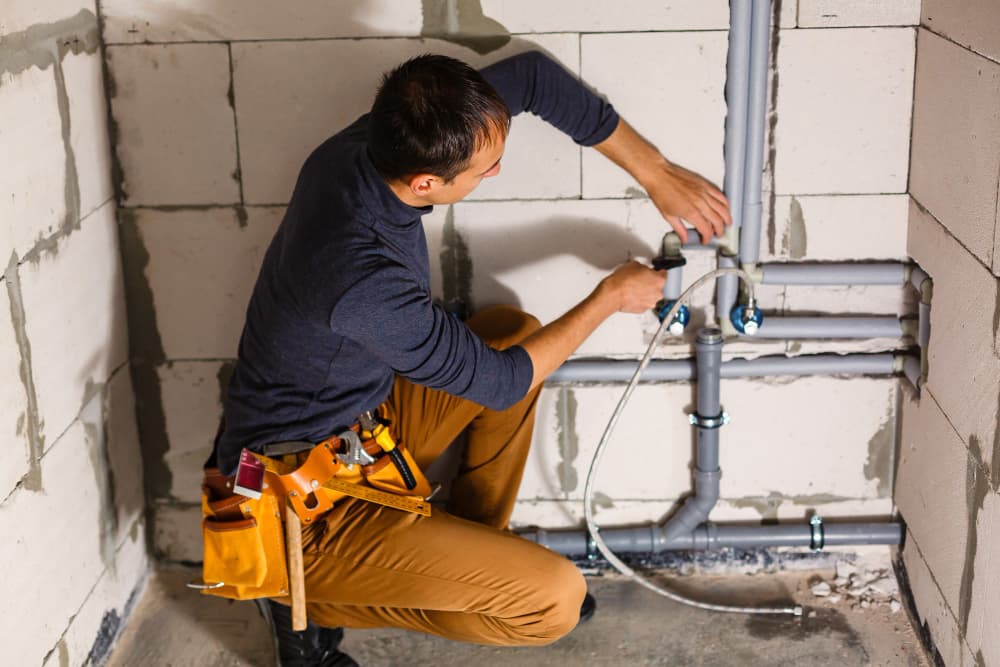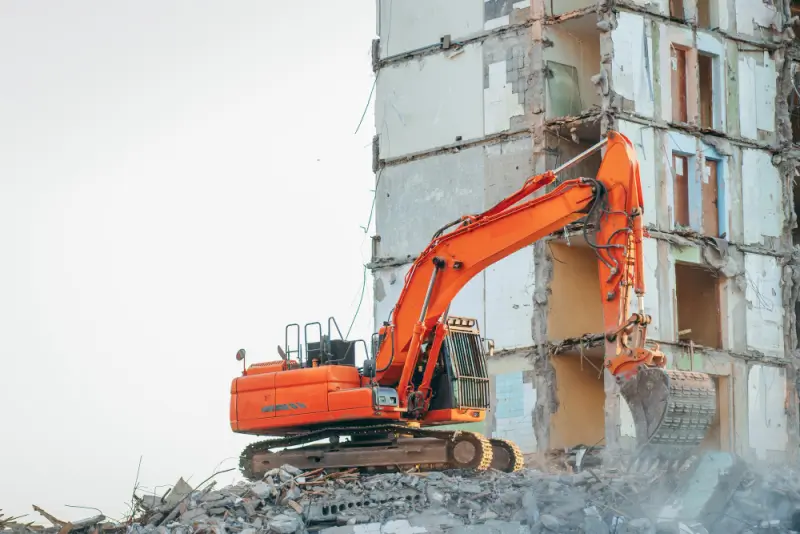Understanding how plumbing works in construction is essential for keeping your project on schedule and within budget. Whether you're managing a residential build in Texas or a commercial development in Florida, knowing the ins and outs of plumbing installation helps you avoid costly mistakes and delays.

The Three Critical Phases of Plumbing Works in Construction
Most construction projects follow three distinct plumbing phases. Each phase requires specific expertise and careful coordination with other trades.
Phase 1: Underground Rough-In – The Foundation of Your Plumbing System
The underground rough-in establishes everything below ground level. This phase happens before you pour concrete, so mistakes here become expensive fast.
What happens during underground plumbing works in construction:
Your plumbing crew installs the drain, waste, and vent (DWV) system layout. They lay pipes, position drains, and connect water supply lines that run beneath your foundation. Every measurement matters – one bad calculation means jackhammering through fresh concrete later.
The team tests every joint and connection for air and water tightness before concrete gets poured. This pressure testing catches problems when they're still easy to fix.
Common challenges in underground plumbing:
- Sandy soil that caves in and requires extra excavation
- Rocky terrain that slows down digging and increases labor costs
- Wet conditions that make pipe joining difficult
- Shale that demands additional effort and specialized equipment
Pro tip: Use specialized products like Rain-R-Shine joining compounds for wet conditions to keep your schedule moving.
Phase 2: Above-Ground Rough-In – Building the Interior Network
Once your foundation is solid, plumbing works in construction move above ground. This phase installs everything behind your walls before drywall goes up.
Your crew installs water supply lines, waste and vent pipes, and gas lines. They need exact fixture locations – sinks, toilets, showers, and appliances. Most builders rely on fixture books or submittals to ensure installers know precisely where to place waste and water pipes.
Key tasks in above-ground plumbing:
- Installing hot and cold water supply lines throughout the structure
- Venting the DWV system properly to prevent drainage issues
- Running gas lines to appliances
- Coordinating with electricians to avoid conflicts
Communication becomes critical here. Electricians and plumbers must work together closely. A misplaced electrical box can block a plumbing vent. A poorly routed water line can interfere with electrical conduit.
Testing happens again – pipes get capped off and filled with water to check for leaks. Some jurisdictions require vacuum testing too. Always check your local building codes.
Phase 3: Finish Work – Completing the Plumbing Installation
The finish phase happens after drywall, paint, and tile work wraps up. Your plumbing team returns to install visible fixtures and make final connections.
Finish work includes:
- Setting toilet flanges and mounting toilets
- Installing sinks, faucets, and washing machine connections
- Connecting appliances to drains and water supply
- Installing trim kits for tubs and showers
- Caulking fixtures to prevent water damage
Hot water gets introduced during this phase. You'll work with your plumber to set appropriate water temperatures for safety and efficiency.
Final testing uses sensitive equipment like manometers to detect even tiny pressure changes. This comprehensive test ensures the entire system is sealed tight and absolves your plumbing contractor of liability for future issues.
Essential Components of Plumbing Works in Construction
Water Supply Systems
The water supply system delivers clean water from the main line to every fixture. Most residential projects use 3/4-inch copper or PEX lines entering the building, branching to 1/2-inch lines for individual fixtures.
Common pipe materials:
- Copper pipes: Durable and corrosion-resistant, perfect for long-term reliability
- PEX pipes: Flexible and quick to install, reducing labor costs significantly
- PVC pipes: Lightweight and chemical-resistant for drain and waste systems
Modern construction increasingly favors PEX for its flexibility and ease of installation. A skilled crew can rough in a house's water supply in a fraction of the time copper requires.
Drainage and Venting Systems
Drainage removes wastewater safely. Venting prevents vacuum conditions that would slow drainage and allow sewer gases inside.
Key drainage components:
- Drain pipes sloped properly for gravity flow (typically 1/4 inch per foot)
- P-traps that hold water to block sewer gas
- Vent pipes extending through the roof for air circulation
- Cleanouts for maintenance access
Improper venting causes gurgling drains and slow flow. It's one of the most common mistakes in amateur plumbing work.
Gas Supply Systems (When Applicable)
Gas lines require specialized certification. Your plumber installs pipes delivering natural gas or propane to water heaters, furnaces, stoves, and dryers.
Safety is paramount – gas work demands licensed professionals and thorough pressure testing. Never cut corners on gas installation.
Building Code Requirements for Plumbing Works in Construction
Every jurisdiction has specific plumbing codes. Most follow the International Plumbing Code (IPC) or Uniform Plumbing Code (UPC), but local amendments vary.
Typical inspection points:
- Underground rough-in inspection before concrete pour
- Above-ground rough-in inspection before walls close up
- Final inspection after fixture installation
Missing an inspection can halt your entire project. Schedule inspections early and know your inspector's availability.
Understanding Pipe Sizing in Plumbing Works for Construction
Proper pipe sizing ensures adequate water pressure and drainage throughout your building. Getting this wrong causes low pressure, slow drains, and frustrated occupants.
Standard residential pipe sizes:
- Main water supply line: 3/4 inch to 1 inch
- Branch lines to fixtures: 1/2 inch
- Toilet drains: 3 inches minimum
- Sink drains: 1-1/2 to 2 inches
- Shower and tub drains: 2 inches
- Main drain stack: 3 to 4 inches
Commercial buildings require larger pipes due to higher demand. A commercial kitchen needs completely different sizing than residential applications. Your plumber calculates fixture units to determine appropriate pipe sizes based on expected usage.
Water velocity matters too. Pipes sized too small create noise and wear out faster from excessive water speed. Oversized pipes waste money and can cause drainage issues in waste systems.

Common Plumbing Mistakes That Delay Construction Projects
Inadequate planning: Rushing through design creates conflicts with other trades later. Take time upfront to coordinate fixture locations and pipe routing.
Poor material selection: Cheap pipes save pennies today but cost thousands in callbacks tomorrow. Invest in quality materials appropriate for your climate and water conditions.
Skipping pressure tests: Every phase needs thorough testing. Finding leaks early prevents major damage and expensive repairs.
Ignoring venting requirements: Proper venting seems invisible but prevents numerous problems. Don't shortcut vent sizing or placement.
Miscommunication between trades: Plumbers, electricians, and HVAC crews must coordinate. Regular coordination meetings prevent conflicts that delay projects.
Water Efficiency in Modern Plumbing Construction
Today's building codes increasingly emphasize water conservation. Low-flow fixtures reduce consumption without sacrificing performance.
Water-efficient options:
- Low-flow toilets using 1.28 gallons per flush or less
- WaterSense-labeled faucets and showerheads
- Tankless water heaters that eliminate standby energy loss
- Proper pipe insulation reducing heat loss
Energy-efficient plumbing reduces operating costs and increases property value. Buyers and tenants value lower utility bills.
Regional Considerations for Plumbing Works in Construction
Plumbing requirements vary by climate and geography. What works in Minnesota won't work in Florida.
Cold climate considerations:
- Deeper frost lines require deeper pipe burial
- Pipe insulation prevents freezing
- Heat tape for exposed pipes in crawl spaces
Hot climate considerations:
- UV-resistant materials for exposed exterior pipes
- Thermal expansion accommodations for hot climates
- Cross-connection control in areas with low water pressure
Coastal areas:
- Corrosion-resistant materials for salt air exposure
- Backflow prevention for areas prone to flooding
- Hurricane-resistant fixture mounting
Understanding these regional differences helps you hire crews with relevant local experience.
Troubleshooting Common Issues in Plumbing Works During Construction
Catching problems early saves massive headaches later. Here are the most frequent issues and how to spot them.
Leaking pipes: Usually stem from poor connections, damaged fittings, or overtightened joints. Pressure testing reveals these before drywall goes up. Look for water stains, dampness, or pressure drops during testing.
Clogged drains: Construction debris often causes blockages during installation. Require workers to cap open pipes when not actively working. Clean drains thoroughly before final connections.
Low water pressure: Check for kinked PEX lines, partially closed valves, or undersized pipes. Water pressure should measure 40-80 PSI at fixtures. Less than 40 PSI causes poor performance.
Gurgling drains: Usually indicates venting problems. Improper vent sizing or blocked vent pipes create vacuum conditions. Double-check vent pipe routing and termination above the roof line.
Sewer gas odors: Dry P-traps or missing traps allow sewer gases inside. Every fixture needs a properly installed trap. Pour water in floor drains and rarely-used fixtures to maintain the water seal.
Frozen pipes: In cold climates, ensure adequate insulation on exterior walls and crawl spaces. Pipes need minimum R-13 insulation in unconditioned spaces. Heat tape provides additional protection for vulnerable areas.
Maintaining Quality Throughout Your Plumbing Installation
Quality control prevents callbacks and protects your reputation. Implement these best practices:
Document everything: Photograph pipe layouts before closing walls. Create as-built drawings showing exact pipe locations for future reference.
Use proper materials: Don't mix incompatible pipe types without appropriate transition fittings. Follow manufacturer installation guidelines precisely.
Test thoroughly: Pressure test at multiple stages, not just final inspection. Catch problems early when fixes are simple.
Coordinate schedules: Ensure plumbing rough-in completes before other trades start work that could interfere. Clear communication prevents conflicts.
Verify code compliance: Stay current on code changes in your jurisdiction. What passed inspection last year might not meet current requirements.
The Bottom Line on Plumbing Works in Construction
Understanding how plumbing works in construction helps you avoid costly mistakes and complete projects on schedule. The three-phase approach – underground rough-in, above-ground rough-in, and finish work – provides a proven framework for successful plumbing installation.
Quality plumbing requires skilled professionals who understand both the technical requirements and local building codes. Invest in experienced licensed plumbers who communicate well with other trades on your site.
Key takeaways for successful plumbing installation:
- Plan thoroughly before breaking ground
- Test at every phase, not just final inspection
- Use quality materials appropriate for your climate
- Coordinate closely between all trades
- Follow local building codes to the letter
- Document everything with photos and as-built drawings
Proper plumbing installation protects your investment and reputation. Shortcuts today become expensive callbacks tomorrow. Taking time to understand how plumbing works in construction pays dividends throughout your project and long after completion.
Frequently Asked Questions About Plumbing Works in Construction
What are the three main phases of plumbing installation in construction?
The three phases are underground rough-in (below ground level before concrete), above-ground rough-in (behind walls before drywall), and finish work (installing visible fixtures). Each phase requires inspection before proceeding to the next stage.
How long does plumbing rough-in take for a typical house?
Underground rough-in typically takes 1-3 days depending on site conditions. Above-ground rough-in takes 3-5 days for an average single-family home. Finish work usually requires 2-3 days after other trades complete their work.
What type of plumbing pipe is best for new construction?
PEX (cross-linked polyethylene) has become the standard for water supply lines in new residential construction due to flexibility, freeze resistance, and installation speed. PVC remains popular for drain, waste, and vent systems. Your local code and specific application determine the best choice.
Do I need a licensed plumber for all plumbing work in construction?
Most jurisdictions require licensed plumbers for all plumbing installation, modification, and repair work. Some areas allow unlicensed workers to assist under licensed supervision. Always check your local building code requirements before starting work.
How much does plumbing cost for new construction?
Plumbing typically costs $4,000-$12,000 for a 2,000 square foot home, varying by region, material choices, and fixture quality. Commercial projects cost more due to code requirements and system complexity. Get multiple quotes from licensed contractors for accurate pricing.
What are the most common plumbing mistakes in construction?
The biggest mistakes include inadequate venting, improper pipe slope, skipping pressure tests, poor coordination with other trades, and using incompatible materials. These errors cause drainage problems, leaks, and code violations that delay projects.
How do I find qualified plumbing contractors for my construction project?
Verify current licensing with your state's licensing board, check insurance coverage including general liability and workers' compensation, review recent similar projects, and contact multiple references. Ask about their experience with your specific type of project and familiarity with local code requirements. Interview at least three contractors and compare detailed written bids.
When should plumbing inspections happen during construction?
Inspections typically occur at three stages: after underground rough-in before concrete pour, after above-ground rough-in before closing walls, and after finish work completion. Schedule inspections promptly to avoid project delays.
What plumbing codes apply to construction projects?
Most areas follow the International Plumbing Code (IPC) or Uniform Plumbing Code (UPC) with local amendments. Your jurisdiction's building department enforces specific requirements. Always consult local codes before beginning plumbing work.
How can I prevent plumbing problems in new construction?
Use quality materials, hire licensed professionals, test thoroughly at each phase, document installations with photos, coordinate between trades effectively, and ensure proper inspections. Investing in quality upfront prevents expensive callbacks later.
What's the difference between PEX and copper plumbing?
PEX is flexible plastic tubing that's faster to install, resistant to freezing, and less expensive than copper. Copper is more rigid, extremely durable, and has a longer track record. Both meet code requirements, but PEX has largely replaced copper in residential construction due to cost and installation advantages.
How deep should plumbing pipes be buried?
Burial depth depends on your local frost line. Cold climates require deeper burial – often 4-6 feet below grade. Warm climates may only require 18-24 inches. Always follow local code requirements for your specific region.
Looking for more construction insights? Check out our other guides on electrical systems, HVAC installation, and framing best practices to help your projects run smoothly from start to finish.



